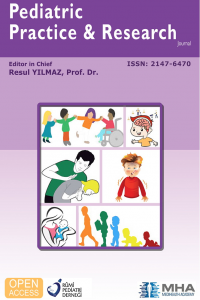Lung Ultrasound in Hemodynamic Assessment
The newborns with compromised hemodynamics and respiratory failure are on higher risks for multiple adverse outcomes. Care of these patients is a challenging issue. Traditional bedside physical examination can be misleading. The chest X-ray and/or chest computerized tomography are the main imaging tools in the diagnosis of lung diseases. In neonatal respiratory and hemodynamic compromise, a combined heart and lung evaluation may help to assess the organ functions. Recently, targeted neonatal echocardiography (TNE) and point-of-care ultrasound (POC-LUS) have been integrated into clinical care in NICUs. POC-LUS is a easy-to-learn, radiation-free, bedside, quick and repeatable diagnostic method that can be performed in the NICU at the bedside. LUS can reliably and accurately diagnose many neonatal pulmonary diseases such as respiratory distress syndrome (RDS), transient tachypnea of the newborn (TTN), meconium aspiration syndrome (MAS), pneumonia, and pneumothorax.
Keywords:
Lung Ultrasound in,
___
- References: 1- Elsayed YN. Lung Ultrasound as a New Technique for Diagnosis of Neonatal Respiratory Diseases. Neonatal Netw. 2018 Jul;37(4):224-232. 2- King A et al. Tools to assess lung aeration in neonates with respiratory distress syndrome. Acta Paediatr. 2019 Sep 19. doi: 10.1111/apa.15028 3- Dilli D et al. Comparison of three natural surfactants according to lung ultrasonography scores in newborns with respiratory distress syndrome. J Matern Fetal Neonatal Med. 2019 Jul 24:1-7. 4- Raimondi F et al. Lung Ultrasound for Diagnosing Pneumothorax in the Critically Ill Neonate. J Pediatr. 2016 Aug;175:74-78.e1
- ISSN: 2147-6470
- Başlangıç: 2013
- Yayıncı: MediHealth Academy Yayıncılık
Sayıdaki Diğer Makaleler
İnsan İnsana İlişki Modeli İle Trakeostomili Çocuk Hastanın Ailesine Yaklaşım: Olgu Sunumu
Kezban ÖZTÜRK, Abdullah YAZAR, Abdullah YAZAR, Semih ERDEN, Alper YILDIRIM, Hüseyin ÇAKSEN
Ahmet Emre HATIR, Sevgi PEKCAN
Current Approaches in Nausea and Vomiting Management in Children Undergoing Chemotherapy
Hazal ÖZDEMİR, Fatma TAŞ ARSLAN
Çoçuklarda Sağlık Okuryazarlığının Geliştirilmesinde Aile Eğitimi
